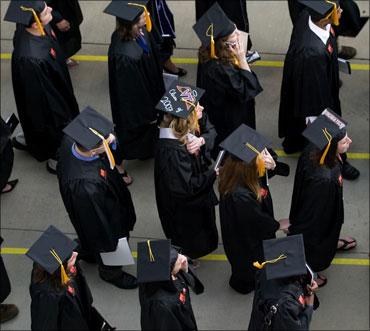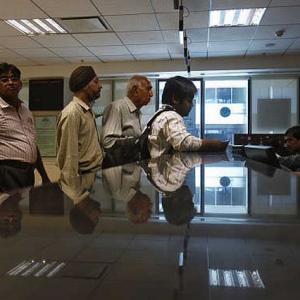
With fresh enrollments crossing 100,000 mark, the total number of Indian students studying in the US reported a sharp increase this year, reports Aziz Haniffa/Rediff.com
After three straight years of decline, the number of Indian students on US campuses recorded an increase of 6 per cent.
With 102,673 students on the roll, the number has crossed the 1,00,000 mark for the first time since 2008-2009 thanks to a spurt of enrollment at the graduate level.
However India was no match for the strong growth of students from China, particularly at the undergraduate level.
With 274,000 enrollments from China, the intake increased by 17 per cent in total and 18 per cent at the undergraduate level to retain its number one spot.
However, this was a slightly lower rate of growth than the previous year.
Students from China now make up 31 per cent of all international students in the United States.
India had been the leading country of origin for international students in the US from 2001-02 through 2008-09.
In 2000-01, international organisation Open Doors had reported a 30 per cent surge of enrollments from India, followed by two more years of strong growth -- 12 per cent in 2002-03, and 7 per cent in 2003-04.
The increase tapered off in 2004-05, and decreased slightly for the next two years.
In 2009-10, the increases levelled off and China retained its lead as the top sender of students to the US, a position the country has maintained since.
There were also large increases in students from several countries where the national governments have been investing in scholarship programmes to send their students to the United States to study.
This year, there was a 22 per cent increase in students from Brazil, to a total of more than 13,000.
Brazil moved up to number 10, reflecting the effects of the second full year of undergraduate students coming to the United States with scholarships from the Brazilian Government’s Brazil Scientific Mobility Programme.
There was a 21 per cent increase in the number of students from Saudi Arabia.
Nearly 54,000 Saudi students are studying in the United States, largely funded by the Saudi government scholarship programme, now approaching its 11th year.
On a smaller scale, the continued expansion of the Kuwaiti government scholarship programmes led to 43 per cent more students coming from Kuwait. With its more than 7,300 students, Kuwait is now the 21st leading place of origin, after joining the top 25 list the previous year.
The 2014 Open Doors Report on International Educational Exchange, published by the International Institute of Education was released at the National Press Club here on the occasion of the 15th annual celebration of International Education Week, and as in previous years was a joint initiative of the US Department of State and the US Department of Education.
According to the Open Doors date, students from the top three places of origin -- China, India, and South Korea -- now represent approximately 50 per cent of the total enrollment of international students in the United States, with the number from China and India increasing, and the numbers from South Korea declining.
This year, Saudi students represent six per cent of the total.
After these top four countries, no country represents more than 5 per cent of the total international students in the United States.
Each of the top 25 places of origin had 5,000 or more students in the United States.
There were increases in the number of students from 17 of the top 25 places of origin, including Brazil, Canada, China, Colombia, Germany, Hong Kong, India, Indonesia, Iran, Kuwait, Mexico, Nigeria, Saudi Arabia, Spain, the United Kingdom, Venezuela and Vietnam.
The number of students from France, Malaysia, and Thailand remained relatively flat. Japan, which had seen steep declines in prior years, leveled off to a decrease of only about one per cent, due in part to concerted efforts of the Japanese and US governments.
There were declines in the number of students from the third leading sender, South Korea (down 4 per cent), as well as from Taiwan (down 3 per cent), Turkey (down 4 per cent), and Nepal (down 9 per cent). The factors driving these declines, according to the report likely include a mix of global and local economic factors, and in some cases expanded higher education opportunities at home.
Overall, according to the report, the number of international students enrolled in US higher education increased by eight per cent to 886,052 students in 2013/14, with 66,408 more students than last year enrolled in colleges and universities across the United States.
This marked the eighth consecutive year that Open Doors has reported expansion in the total number of international students in US higher education.
There are now 72 per cent more international students studying at US colleges and universities than were reported in Open Doors 2000, and the rate of increase has risen steadily for the past four years.
However, it acknowledged, despite the increases in recent years, international students still constitute approximately four per cent of the more than 21 million students enrolled in US for higher education.
But the report argued that the increase by eight per cent to a record high of 886,052 students for the 2013/14 academic year, confirmed once again that the United States remains the destination of choice for higher education.
It noted, that the United States hosts more of the world's 4.5 million globally mobile college and university students than any other country in the world, with almost double the number hosted by the United Kingdom, the second leading host country.
The report also found that more American students -- a total of 289,408 -- studied abroad for academic credit from their US colleges and universities, although the two per cent increase represents a slightly slower rate of growth than the previous year.
It said that this year's statistics document how much more global US higher education has become since the launch of the initiative and pointed out that the overall number of international students in the United States has grown by 72 per cent since the first International Education Week briefing was held in 2000.
The report said there are five times as many Chinese students on US campuses as were reported in Open Doors 2000, almost two and a half times as many Indian students, seven and a half times as many Vietnamese students, and more than ten times as many Saudi students.
The number of US students studying abroad has more than doubled in the last 15 years, it added.
International students' spending in all 50 states contributed more than $27 billion to the US economy in 2013, according to the US Department of Commerce.
Evan M Ryan, Assistant Secretary of State for Educational and Cultural Affairs, said at the briefing coinciding with the release of the report that 'international education is crucial to building relationships between people and communities in the United States and around the world.'
He argued, 'It is through these relationships that together we can solve global challenges like climate change, the spread of pandemic disease, and combating violent extremism.'
Ryan also remarked, 'We also need to expand access to international education for students from more diverse backgrounds, in more diverse locations of study, getting more diverse types of degrees. Only by engaging multiple perspectives within our societies can we all reap the numerous benefits of international education -- increased global competence, self-awareness and resiliency, and the ability to compete in the 21st century economy.'
Echoing his sentiments, IIE's president, Dr Allan E Goodman, said, 'International experience is one of the most important components of a 21st century education, and study abroad should be viewed as an essential element of a college degree.'
'Learning how to study and work with people from other countries and cultures also prepares future leaders to contribute to making the world a less dangerous place,' he added.
The report said that 41 states experienced growth in the number of international students, with 18 states growing at a faster rate than the national increase of 8 per cent. New York University became the leading host university for international students this year, after 12 years during which University of Southern California was the leader.
For the first time ever, four institutions broke the 10,000 mark-- New York University, University of Southern California, University of Illinois – Urbana-Champaign, and Columbia University, which each hosted more than 10,000 international students.
The UK had the largest increase in the number of US study abroad students.
In addition, there was double digit growth in the number of American students studying in South Africa, Denmark, South Korea, Peru, and Thailand, as well as strong growth to Costa Rica and Ireland and a continued rebound in those going to Japan as programmes recovered after the earthquake and tsunami of March 2011.
There were declines in the number of American students going to China, Australia, Argentina, India, Mexico, Ecuador, Israel, Chile, and New Zealand.
Despite these increases, fewer than 10 per cent of all US college students study abroad at some point during their undergraduate years.
American students majoring in STEM (Science, Technology, Engineering, and Math) fields showed the largest increase in study abroad, up 9 per cent from the prior year, outnumbering study abroad students in the Social Sciences, the second largest field.
Photo: Chris Keane/Reuters
ALSO SEE









